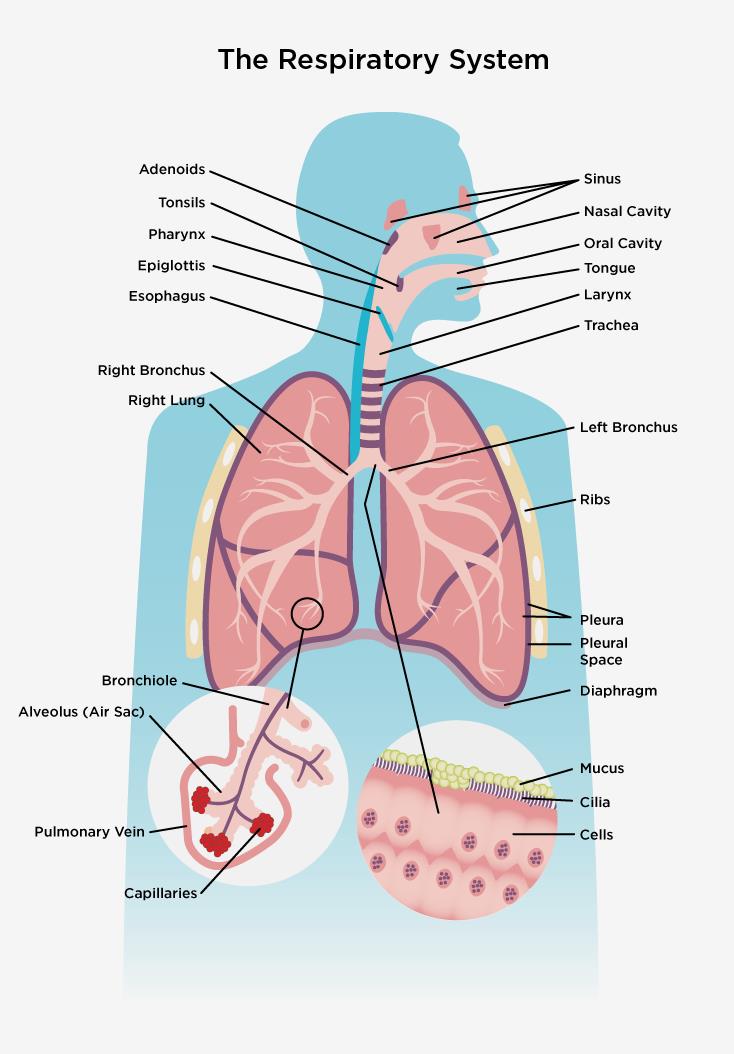Organs of the Respiratory System Easy Picturer

This chart of the RESPIRATORY SYSTEM shows how you breathe.
Breathing is the process that brings oxygen in the air into your lungs and moves oxygen and through your body. Our lungs remove the oxygen and pass it through our bloodstream, where it's carried off to the tissues and organs that allow us to walk, talk, and move.
Our lungs also take carbon dioxide from our blood and release it into the air when we breathe out.
The SINUSES are hollow spaces in the bones of your head. Small openings connect them to the nasal cavity. The sinuses help to regulate the temperature and humidity of air your breathe in, as well as to lighten the bone structure of the head and to give tone to your voice.
The NASAL CAVITY (nose) is the best entrance for outside air into your respiratory system. The hairs that line the inside wall are part of the air-cleansing system.
Air can also enters through yourORAL CAVITY (mouth), especially if you have a mouth-breathing habit or your nasal passages may be temporarily blocked.
The ADENOIDS are overgrown lymph tissue at the top of the throat. When your adenoids interfere with your breathing, they are sometimes removed. The lymph system, consisting of nodes (knots of cells) and connecting vessels, carries fluid throughout the body. This system helps your body resist infection by filtering out foreign matter, including germs, and producing cells (lymphocytes) to fight them.
The TONSILS are lymph nodes in the wall of your pharynx. Tonsils are not an important part of the germ-fighting system of the body. If they becomehen infected, they are sometimes removed.
The PHARYNX (throat) collects incoming air from your nose and passes it downward to your trachea (windpipe).
The EPIGLOTTIS is a flap of tissue that guards the entrance to your trachea. It closes when anything is swallowed that should go into the esophagus and stomach.
The LARYNX (voice box) contains your vocal cords. When moving air is breathed in and out, it creates voice sounds.
The ESOPHAGUS is the passage leading from your mouth and throat to your stomach.
The TRACHEA (windpipe) is the passage leading from your pharynx to the lungs.
The RIBS are bones supporting and protecting your chest cavity. They move a small amount and help the lungs to expand and contract.
The trachea divides into the two main BRONCHI (tubes), one for each lung. The bronchi, in turn, subdivide further into bronchioles.
The RIGHT LUNG is divided into three LOBES, or sections.
The left lung is divided into two LOBES.
The PLEURA are the two membranes that surround each lobe of your lungs and separate the lungs from your chest wall.
The bronchial tubes are lined with CILIA (like very small hairs) that have a wave-like motion. This motion carries MUCUS (sticky phlegm or liquid) upward and out into the throat, where it is either coughed up or swallowed. The mucus catches and holds much of the dust, germs, and other unwanted matter that has invaded your lungs. Your lungs get rid of the mucus through coughing.
The DIAPHRAGM is the strong wall of muscle that separates your chest cavity from your abdominal cavity. By moving downward, it creates suction to draw in air and expand the lungs.
The smallest section of the bronchi are called BRONCHIOLES, at the end of which are the alveoli (plural of alveolus).
The ALVEOLI are the very small air sacs that are the destination of air that you breathe in. The CAPILLARIES are blood vessels that are imbedded in the walls of the alveoli. Blood passes through the capillaries, brought to them by the PULMONARY ARTERY and taken away by the PULMONARY VEIN. While in the capillaries, the blood moves carbon dioxide into the alveoli and takes up oxygen from the air in the alveoli.
Source: https://www.lung.ca/lung-health/lung-info/respiratory-system
0 Response to "Organs of the Respiratory System Easy Picturer"
Enviar um comentário